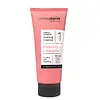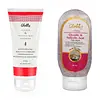What's inside
What's inside
 Key Ingredients
Key Ingredients

 Benefits
Benefits

 Concerns
Concerns

 Ingredients Side-by-side
Ingredients Side-by-side

Water
Skin ConditioningPalmitic Acid
EmollientGlycerin
HumectantMyristic Acid
CleansingCocamidopropyl Betaine
CleansingLauric Acid
CleansingPotassium Hydroxide
BufferingStearic Acid
CleansingTrehalose
HumectantSodium Bicarbonate
AbrasiveCalamine
AbsorbentDisodium EDTA
Salicylic Acid
MaskingSodium Hyaluronate
HumectantPropylene Glycol
HumectantAloe Barbadensis Leaf Extract
EmollientAlpha-Glucan Oligosaccharide
CleansingPropanediol
SolventPolymnia Sonchifolia Root Juice
Skin ConditioningMaltodextrin
AbsorbentTriethoxycaprylylsilane
Butylene Glycol
HumectantLactobacillus
Skin ConditioningLactic Acid
BufferingSolanum Lycopersicum Calyx Extract
Skin ConditioningCitrus Limon Fruit Extract
MaskingCitrus Grandis Extract
AntimicrobialVaccinium Myrtillus Bud Extract
AntioxidantMalic Acid
BufferingCitric Acid
BufferingWater, Palmitic Acid, Glycerin, Myristic Acid, Cocamidopropyl Betaine, Lauric Acid, Potassium Hydroxide, Stearic Acid, Trehalose, Sodium Bicarbonate, Calamine, Disodium EDTA, Salicylic Acid, Sodium Hyaluronate, Propylene Glycol, Aloe Barbadensis Leaf Extract, Alpha-Glucan Oligosaccharide, Propanediol, Polymnia Sonchifolia Root Juice, Maltodextrin, Triethoxycaprylylsilane, Butylene Glycol, Lactobacillus, Lactic Acid, Solanum Lycopersicum Calyx Extract, Citrus Limon Fruit Extract, Citrus Grandis Extract, Vaccinium Myrtillus Bud Extract, Malic Acid, Citric Acid
Glycolic Acid 2%
BufferingSalicylic Acid 1%
MaskingAloe Barbadensis Extract 5%
Skin ConditioningTocopherol 0.5%
AntioxidantMyristic Acid
CleansingGlycerin
HumectantDMDM Hydantoin
PreservativePropylene Glycol
HumectantPotassium Hydroxide
BufferingPalmitic Acid
EmollientDecyl Glucoside
CleansingLauric Acid
CleansingGlycol Stearate
EmollientPolyethylene
AbrasivePolyquaternium-1
Disodium EDTA
Water
Skin ConditioningIngredients Explained
These ingredients are found in both products.
Ingredients higher up in an ingredient list are typically present in a larger amount.
Disodium EDTA plays a role in making products more stable by aiding other preservatives.
It is a chelating agent, meaning it neutralizes metal ions that may be found in a product.
Disodium EDTA is a salt of edetic acid and is found to be safe in cosmetic ingredients.
Learn more about Disodium EDTAGlycerin is already naturally found in your skin. It helps moisturize and protect your skin.
A study from 2016 found glycerin to be more effective as a humectant than AHAs and hyaluronic acid.
As a humectant, it helps the skin stay hydrated by pulling moisture to your skin. The low molecular weight of glycerin allows it to pull moisture into the deeper layers of your skin.
Hydrated skin improves your skin barrier; Your skin barrier helps protect against irritants and bacteria.
Glycerin has also been found to have antimicrobial and antiviral properties. Due to these properties, glycerin is often used in wound and burn treatments.
In cosmetics, glycerin is usually derived from plants such as soybean or palm. However, it can also be sourced from animals, such as tallow or animal fat.
This ingredient is organic, colorless, odorless, and non-toxic.
Glycerin is the name for this ingredient in American English. British English uses Glycerol/Glycerine.
Learn more about GlycerinLauric Acid is a fatty acid or lipid. About half of fatty acids in coconut oil is lauric acid.
This ingredient helps hydrate and sooth skin. As a humectant, it helps trap moisture. It also aids in cleaning and enhancing the texture of products.
Lauric acid may not be Malassezia folliculitis, or fungal acne, safe.
Learn more about Lauric AcidMyristic Acid is a saturated fatty acid. It is naturally found in milk fat. Other sources include palm oil, coconut oil, and butter fat.
Myristic Acid is an emulsifer and cleanser. As an emulsifer, it stabilizes a product by preventing ingredients from separating. Myristic Acid helps clean your skin by acting as a surfactant. It tends to gather oil and dirt on your skin to be easily rinsed away.
One study from 2021 found Myristic Acid to have anti-inflammatory properties.
Learn more about Myristic AcidPalmitic Acid is a fatty acid naturally found in our skin and in many plant and animal sources. In cosmetics, it is usually derived from palm oil. It serves many purposes in skincare, acting as a cleanser, emollient, and emulsifier.
As an emollient, palmitic acid helps soften and smooth the skin by preventing water loss. In cleansers, it helps remove oil and dirt while creating foam.
Its emulsifying properties help stabilize products by keeping water and oil-based ingredients from separating.
This may not be suitable for fungal acne-prone skin, as fatty acids like this can sometimes trigger breakouts in sensitive individuals.
Learn more about Palmitic AcidPotassium hydroxide is commonly known as caustic potash. It is used to fix the pH of a product or as a cleaning agent in soap. In cleansers, it is used for the saponification of oils.
Sapnification is the process of creating fatty acid metal salts from triglycerides and a strong base. During this process, Potassium Hydroxide is used up and is not present in the final product.
Using high concentrations of Potassium Hydroxide have shown to irritate the skin.
Learn more about Potassium HydroxidePropylene Glycol is an odorless, colorless liquid. As a humectant, it helps skin retain moisture. It also aids in delivering active ingredients.
Another role of this ingredient is preventing a product from melting or freezing. Propylene glycol also adds antimicrobrial properties to a product, elongating product lifespan.
This ingredient is considered an organic alcohol and commonly added into both cosmetics and foods.
Those with sensitive skin or conditions may develop a rash when using this ingredient.
Learn more about Propylene GlycolSalicylic Acid (also known as beta hydroxy acid or BHA) is a well-known ingredient for treating skin that struggles with acne and clogged pores. It exfoliates both the skin's surface and deep within the pores to help clear out buildup, control oil, and reduce inflammation.
Unlike AHAs (alpha hydroxy acids), salicylic acid is oil-soluble. This allows it to penetrate into pores which makes it especially effective for treating blackheads and preventing future breakouts.
Salicylic acid is also known for its soothing properties. It has a similar structure to aspirin and can calm inflamed or irritated skin, making it a good option for acne-prone skin that is also sensitive.
Concentrations of 0.5-2% are recognized by the U.S. FDA as an over-the-counter topical acne product.
It can cause irritation and/or dryness if one's skin already has a compromised moisture barrier, so it's best to focus on repairing that before introducing this ingredient into your routine.
While salicylic acid does not increase sun sensitivity, it’s still important to wear sunscreen daily to protect your skin.
If you are looking for the ingredient called BHA or Butylated Hydroxyanisole, click here.
Learn more about Salicylic AcidWater. It's the most common cosmetic ingredient of all. You'll usually see it at the top of ingredient lists, meaning that it makes up the largest part of the product.
So why is it so popular? Water most often acts as a solvent - this means that it helps dissolve other ingredients into the formulation.
You'll also recognize water as that liquid we all need to stay alive. If you see this, drink a glass of water. Stay hydrated!
Learn more about Water